| 1. Bofors |
|
Desperate War of Japan in the Pacific |
|
 | 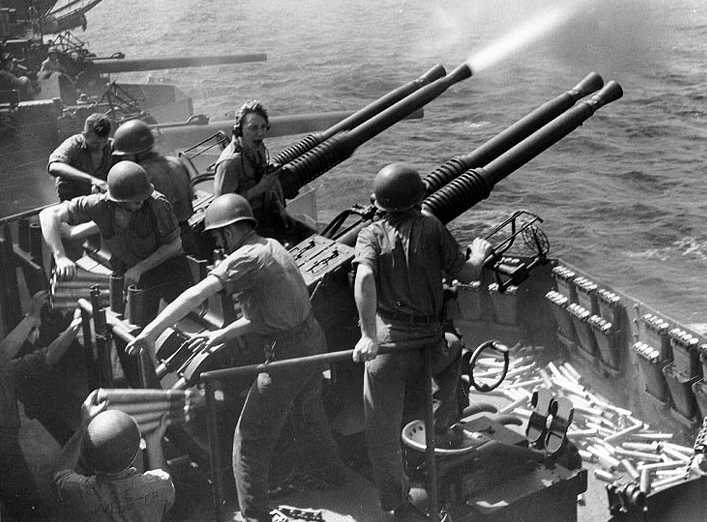 | 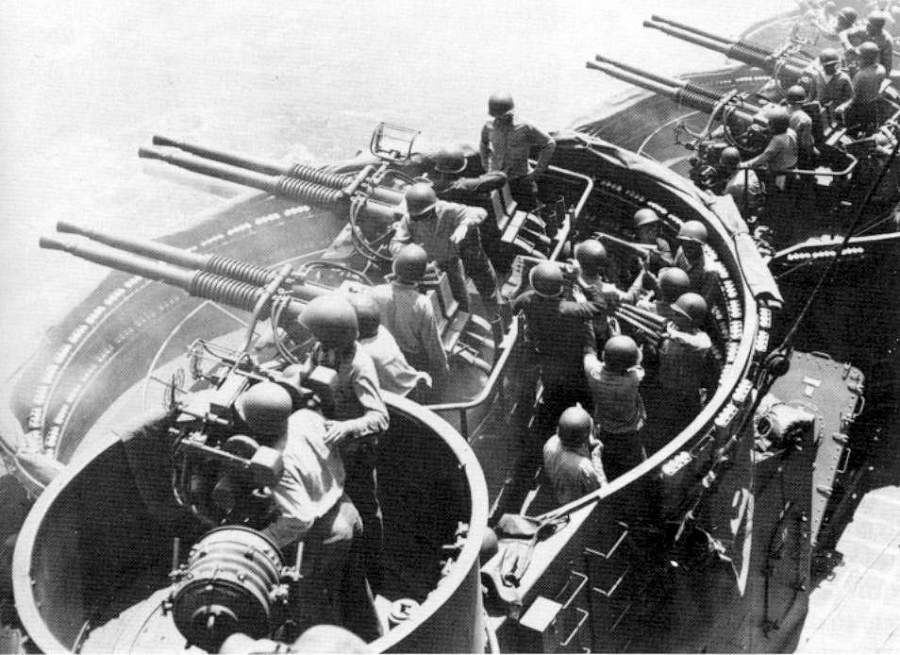 |
|---|
Fig.1 AA gun director| Fig.2 USS Hornet | Fi.3 USS California | |
Fig.2 shows Bofors 40mm quad-gun fire on the USS Hornet in the Pacific in 1945. Fig.3 shows 40mm quad-gun fire with a director on the USS California in 1943. 6 crews carried ammos to load.
My father also carried ammos, when IJN Destroyer Ushio fought anti air combats, though he learned torpedo operation at IJN torpedo school. Ushio had no chance to shoot torpedos in the Leyte Battle.
Did Bofors develop automatic loader? It was diffcult in those days, I think. Sweden is proud of automatic loader of 155 mm self-propelled artillery now. Fig.4 shows USS New Jersey in December 1944. The Bofors gun of US Navy covered up defense gap which ranged from 1,600m (1mi) to 3,000m (9,900ft) height. It was good because divers' attack was about 3,000m (9,900ft) height.
Japan captured a Bofors gun, when she invaded British Malaysia. IJA (Imperial Japanese Army) was interested in its performance and decided it as main AA gun. IJA copied 6 of 40mm Bofors at the Kokura Army Arsenal. Naturally IJA failed to production. IJA tried developing guns that merchant ships equiped, as IJN was not eager to defend them. After all, IJN supplied for 25 mm machin guns for IJA merchant ships.
IJN also copied at the Toyokawa Naval Arsenal separately, the production number is unknown. IJA and IJN also developed aircraft guns independent. A miserable episode of 30 mm machine gun occurred in the end of the Pacific War.
Fig.4 USS New Jersey
 |
Shot down suicide aircraft number
Tokubetu Kogeki-tai
| CAL | Oct1944 | Nov1944 | Dec1944 | Jan1945 |
| 5inVT | 8 | 13% | 4 | 6% | 6 | 12% | 6.5 | 13% |
| 5in | 3.5 | 6% | 9 | 13% | 5 | 10% | 1.5 | 3% |
| 3in | 4 | 7% | 0 | 0% | 1 | 2% | 1.5 | 3% |
| 40mm | 30.5 | 50% | 33 | 47% | 27 | 52% | 23.5 | 53% |
| 20mm | 15 | 25% | 23.5 | 34% | 13 | 25% | 11 | 25% |
| SUM | 61 | 100% | 69.5 | 100% | 52 | 100% | 44 | 100% |
The table shows that 40mm Bofors guns shot down half of suicide aircraft. Including 20mm Oerlikon, The ratio reached 80% nearly. IJN adopted the same 20mm Oerlikon of Switzland as aircraft gun. Fig.5 to Fi.8 show twin 40mm AA guns equipped with light aircraft carrier USS Independence (CVL-22) in 1943. It looks to have fired by direct gunsight. Only battleship or big aircraft carriers controlled AA gun fire, didn't they? Crews of the twin 40mm guns eat sandwitches or somthing. While IJN crews ate rice balls in the same situation. I remember my father had said about sailor's meal.
 |
 |
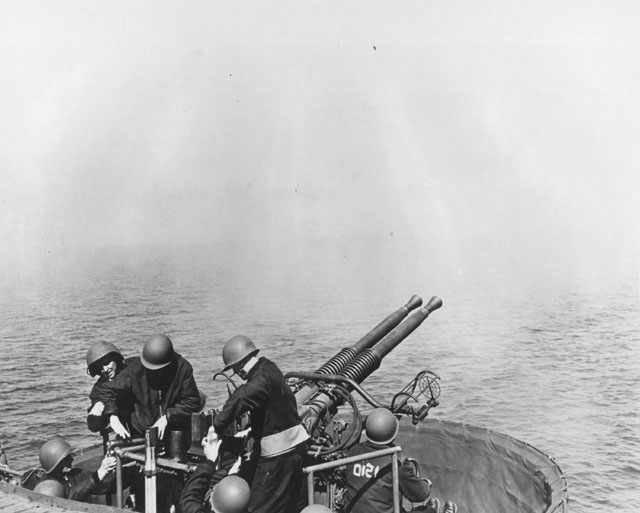 |
 |
| Fig.5 Piping | Fig.6 Cat walk | Fig.7 Loading | Fig.8 Recoil length |
|
| IJN AA defense |
US Navy developed pneumatic and electric Mk.51 with gyros, directing 40mm Bofors or 20mm Oerlikon. Certainly IJN had developed Type 94 in 1934. It was too slow to apply AA gun fire control. There were no hits, when AA guns fired at fukinagashi which a seaplane dragged at 250km/h in 1939. The type 94 was used till the end of the Pacific War. A wireless phone could not always talk to CAP fighters from AA command post from battleship Nagato in a drill of 1941. AA guns could respond to a torpedo plane, as it came close within 1,000m. But it was almost impossible to find a diver on sight. Aircraft carrier was the most fragile against divers, next light cruiser, destroyer, heavy cruiser and battleship.
Chihaya, jyou, p32-p37
|
| My review |
Half view angle of SBD [deg]
| Distance | 50m | 100m | 200m | 500m | 1,000m | 2,000m | 3,000m |
| Angle | 5.8 | 2.9 | 1.4 | 0.58 | 0.29 | 0.14 | 0.096 |
How does view angle vary by distance? My eyes have an ability to realize 1mm pitch far 1.4m in a room. So my half view angle is 0.041°. SBD Dauntless was 5.08m long. The table shows view angle. The SBD would be visible far 3,000 m, if it was still in my sight. If the SBD runs 360 km/h, it is velocity of 100 m/s. In general a man realize a moving or still object in one thirds second. So the SBD runs 33m during the time. Diameter of the SBD ws about 1.2 m. If the SBD dived at 45°, I hardly would see further 1,700m. The SBD would be at 1,200m height then. The SBD would release a bomb at 700 m height, 7 seconds later. 25mm AA guns had to hit during the time. The released bomb is accelerated by gravity. The impact velocity is 155 m/s.
V = ( V0 + 2gh )1/2 h: height, g: gravity
I think that a hit was desperate as Chihaya wrote. Hits or no hits depended on US aviators' skill, I think. USN trained a few skilled divers well on the Midway Battle. A few IJN officers had known the fact, when they saw a Hollywood film of SBD before the Pacific War. Japanese Government had banned the show of the film. RN divers seemed unskilled to attack IJN aircraft carries at the Indian Ocean. Didn't RN train bomber aviators hard? USN sent a lot of aircraft to attack battleship Yamato in Okinawa Battle. Ratio of hits was poor to compare with Battleship Musashi in Leyte.
Although Chihaya told that it was possible to prevent a torpedo plane, view angle was only 0.29° at distance of 1,000m. I think difficult to hit on direct gunsight. I think that IJN AA guns waited for them at the release point and the constant attack angle.
|
| 2. Aircraft gun |
|
IJA and IJN developed aircraft guns independent, and their ammo was not compatible each other at all.
|
| 12.7mm & 20mm |
Independent development
| Caliber | Year | IJA/IJN | Type |
| 12.7mm | 1940 | IJA | Ho-103 |
| 1943 | IJN | Type 3 |
| 20mm | 1939 | IJN | Type 99 |
| 1944 | IJA | Ho-5 |
| 30mm | 1944 | IJA | Ho-155 |
| 1945 | IJN | Type 5 |
US and Japan did a long air battle in New Guinea and the Solomon Islands almost two years. Logistics was critical for both nations to continue battles. USN and USAAF had adopted the same 12.7mm gun for aircraft. IJA fighters aircraft flew to the battle front of the south east Pacific. Ammo shortage troubled IJA fighters at Rabaul seriously. But IJN could not supply with ammos because of no compatibility between IJA and IJN, though they had modified M2 gun independent. IJA succeeded in explosive charge of 12.7mm at fisrt. Why did IJN develop another poor 12.7mm gun in 3 years later? On the contray, IJA could not make much ammo of 20mm gun till March 1944. It was 5 years later after IJN production of Type 99 cannon. And worse production of explosives also was very little compared with the US.
Rikugun-ki tousai kikan-jyu
Danyaku no kikaku
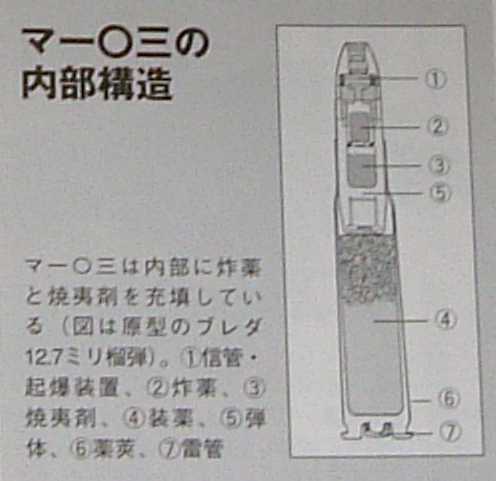 | 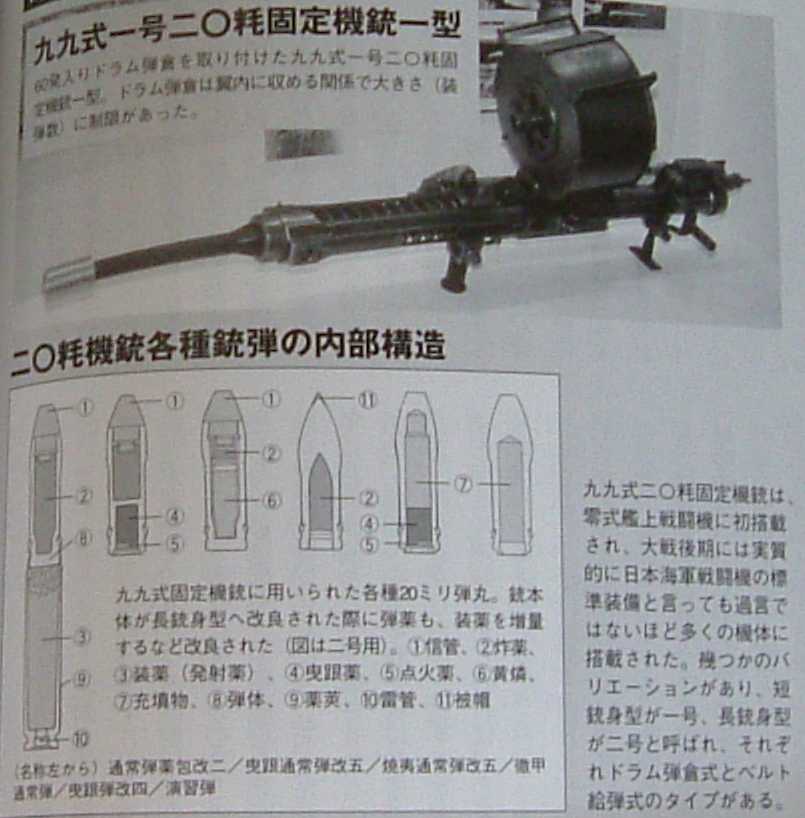 |
| Fig.2 IJA 12.7mm ammo | Fig.1 IJN 20mm gun |
Fig.1 shows 20mm cannon of IJN Type 99 and its ammo. IJN purchased manufacturing licence from Oericon in 1938. Oericon of Switzland developed it in 1934. IJN imported all the machine tools and materials. USN also adopted it for close anti air gun of warships, though USN adopted famous Bofors 40mm cannon later. Fig.2 shows IJA Ma-103 of 12.7mm ammo which was developed at the First Tokyo Arsenal in 1940. It was originated from Breda in Italy. Italy is a cannon country since Renaissance. Ottoman Empire loved Italian guns. JMSDF uses Italian rapid fire cannons now. JMSDF and JAFSDF use the same ammos compatible US now. Fig3 shows IJN and IJA main ammos.
|
| 30mm |
IJN fighter A7M2 was to eqiupped with 30mm guns. An IJN arsenal made 2,000 guns of 30mm. But The fighter was not in time to production. While IJA fighter Ki-84 model hei had prepared for 30mm guns. IJA ordered Nihon Tokusyu Steel Co. to design a trial of 30mm gun in 1940. The fihgter was to load Ho-155 of 30mm guns which were not in time to production.
Gunzo no.89 p.81-89
Kouku kijyu
 | 1. IJN 7.7mm
2. IJN 12.7mm
3. IJN 20mm, Type99 model1
4. IJN 20mm, Type99 model2
5. IJA 20mm, Ho-3
6. IJA 20mm, Ho-5
7. IJA 20mm MG151
8. IJA 12.7mm, Ho-103
9. IJA 7.7mm |
| Fig.3 Ammos of IJN and IJA |
|
Bureaucracy of IJA and IJN prevented cooperation with each other, I think. It concerned a lot of budget. IJN and IJA managed arsenals in which ammos were producted. The arsenals spent a lot of money. There were occupations for high ranked officers in the arsenals. I think this is one of reasons why IJN and IJA developed ammos for aircraft guns independent. We say even now, "Shou-eki atte, koku-eki nasi. (For ministry first, national next)" I wish ammos of JMSDF and Japan Coast Guard are compatible.
aboutMe
© 2007-2011 Enoki Sensor All Rights Reserved
|










